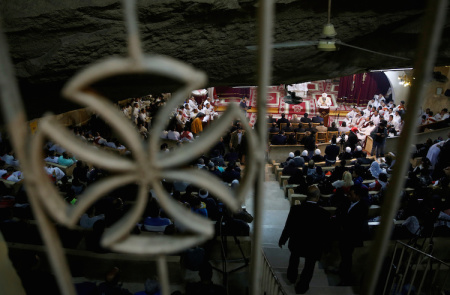Fifth century Christian monastery uncovered in Egypt reveals 'nature of monastic life' in region

Archaeologists have uncovered an ancient Christian monastery complete with three churches, monks' cells and biblical graffiti in Egypt’s Western Desert, revealing monastic life in the region as far back as the fifth century A.D.
French-Norwegian archeologists made the discovery at the Tal Ganoub Qasr al-Agouz site in the Western Desert's Bahariya Oasis, according to a statement from the Egyptian Ministry of Tourism and Antiquities.
"During its third season, the Norwegian-French archaeological mission working in Qasr Al-Agouz in Bahariya Oasis revealed a number of buildings made of basalt stone, carved into rocks and buildings constructed of mud bricks," the statement explains.
The complex comprises six sectors containing the ruins of three churches and monks’ cells.
The “walls bear graffiti and symbols with Coptic connotations,” said Osama Talaat, head of Islamic, Coptic and Jewish Antiquities at the ministry.
Mission head Victor Ghica said that archaeologists made similar excavations of 19 structures embedded in the bedrock last year.
The church walls "bear writings in yellow ink that include religious writings from the Bible in Greek," revealing “the nature of monastic life in the region,” Ghica explained, adding that monks were clearly present there since the fifth century A.D.
The Egyptian Ministry said that the recently-discovered site is very "important" since it reveals previously unknown information about the planning of early monastic buildings and the formation of the first monastic congregations in Egypt.
The Guardian quotes the French Institute of Oriental Archaeology as stating that the site located in the desert southwest of Cairo was occupied from the fourth to eighth centuries, with a likely peak of activity around the fifth and sixth centuries.
The institute — the organization in charge of the mission — added that previous excavations in 2009 and 2013 shed light on other subjects, including “the production and preservation of wine as well as the husbandry of animals” in a monastic context.
In recent months, Egypt has presented several archaeological finds hoping to “revive tourism,” which has suffered in recent years.
The Copts, who make up about 10% of Egypt's population, are the descendants of a long line of ancient Egyptians who later converted to Christianity in the early first century, according to Encyclopedia Britannica.
Christian monasticism first emerged in Egypt at the beginning of the fourth century, originating with St. Anthony, considered the founder and father of the practice.
Anthony began to practice an ascetic life at the age of 20. After 15 years, he withdrew for absolute solitude to a mountain by the Nile River, where he lived from about 286 to 305, notes Encyclopedia Britannica.
The early monks who followed Anthony into the desert "considered themselves the vanguard of God’s army, and, by fasting and performing other ascetic practices, they attempted to attain the same state of spiritual purity and freedom from temptation that they saw realized in Anthony."
When St. Anthony died (circa 356 or 357 A.D.), two types of monasticism flourished in Egypt — villages or colonies of hermits and monasteries that fostered community life.





















